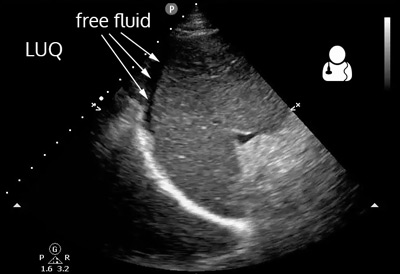The patient is a 24 year old G1P0 at 12 weeks GA who presents to your department with sudden onset severe left flank pain. No history of fertility treatment, no vaginal bleeding. The patient is pale and has severe diffuse abdominal tenderness. BP 82/34 P 135 R 20 T 98.6F.

Diagnosis: Ruptured Splenic Artery Aneurysm (SAA)
This scan demonstrates a clear intrauterine pregnancy and a normal appearing left kidney, no evidence of hydronephrosis. While the splenorenal recess is void of any fluid collections, there is a hypoechoic wedge of free fluid noted above the spleen, at the splenolienal interface.
of hydronephrosis. While the splenorenal recess is void of any fluid collections, there is a hypoechoic wedge of free fluid noted above the spleen, at the splenolienal interface.
- When performing an abdominal ultrasound for free abdominal fluid, it is important to know where fluid will collect first in the various views: In the LUQ view, fluid will counterintuitively first collect above the spleen, in the RUQ fluid will collect first at the inferior pole of the kidney and caudal tip of the liver, and in the female pelvis free fluid will collect first behind the uterus.1
- Since we know this patient has a confirmed IUP, her chance of having an IUP plus a rupturing ectopic pregnancy has been estimated to be 1/30,000, or 0.003% barring any fertility treatment. An IUP essentially rules out ectopic pregnancy here.2
- Although relatively rare (0.1% incidence), SAA carries with it significant mortality if it ruptures. Rupture rate is 10% in the general population, and carries with it a mortality rate of 10-25%.3 This rate increases to 70% if the patient is pregnant, with fetal mortality approaching 95%. Literature shows only 14% of pregnant SAA rupture cases where both mother and fetus survived.4,5,6
- Additionally, pregnancy increases the risk of SAA, and so it should be kept in the differential in pregnant patients who present with sudden onset abdominal or flank pain. 25% of all SAA cases reported in the literature involved patients who were pregnant.6
- For diagnosis, ultrasonography, pulsed Doppler, CTA and MRI are useful, but arteriography is considered the gold standard.7
- Dawson, Mallin. Introduction to Bedside Ultrasound, Volumes 1 and 2. 2013. [inkling]
- Mj G, R R. Heterotopic pregnancy in natural conception. J Hum Reprod Sci. 2008;1 (1): 37-8. [PMC free article]
- Manian U., Badri H., Coyne P., Nice C., Ashour H., Bhattacharya V. Endovascular treatment of a ruptured splenic artery aneurysm using amplatzer ((R)) vascular plug. Int J Biomed Sci: IJBS.2009;5(1):81–84. [PMC free article]
- Vries JE, Schattenkerk ME, Malt RA. Complications of the splenic artery aneurysm other than intraperitoneal rupture. Surgery. 1982;91:200–203. [pubmed]
- Lee PC, Rhee RY, Gordon RY, et al. Management of splenic artery aneurysms: The significance of portal and essential hypertension. J. Am. Coll. Surg. 1999;189:483–490. [pubmed]
- Lynch MJ, Woodford NW. Rupture of a splenic artery aneurysm during pregnancy with maternal and foetal death: a case report. Med Sci Law. 2008;48:(4)342-5. [pubmed]
- Kaszyäski M, Haisiura R. Splenic artery aneurysm: A case report. Med Sci Monit. 1999;5:1213–5.




